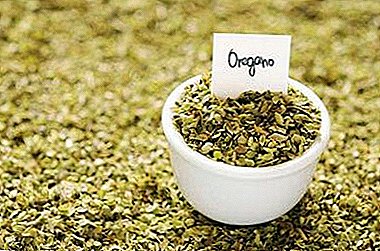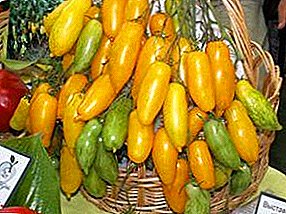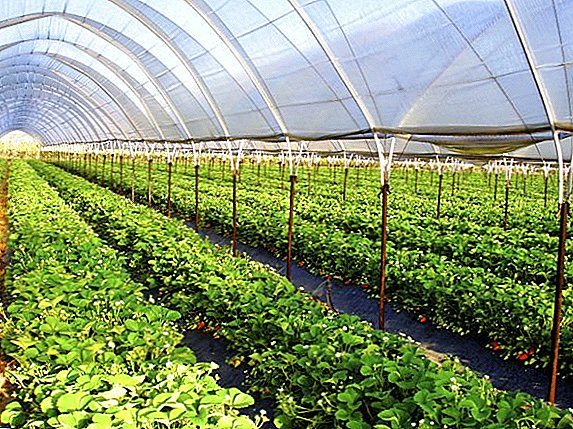 The key to successful keeping of large and small livestock is not only monitoring the quality of food, ensuring regular grazing and optimal "living" conditions of the animal, but also timely treatment and prevention of diseases.
The key to successful keeping of large and small livestock is not only monitoring the quality of food, ensuring regular grazing and optimal "living" conditions of the animal, but also timely treatment and prevention of diseases.
In this article we will look at the ailment that affects the digestive system, which most often happens in cows, - acidosis.
The causes and forms of the disease, methods of treatment and prevention - in more detail in the article.
What it is
Acidosis is a violation of the digestive function, in which a large amount of lactic acid accumulates in the rumen of the cow (the first and largest part of the four-chamber stomach of this ruminant animal).

The disease not only causes the characteristic pain in the stomach and impairs food permeability, but also reduces the overall immunity. As a result, the cow refuses to eat, becomes lethargic, and the volume of milk yields significantly reduced. Acidosis refers to nutritional diseases (those resulting from malnutrition).
Causes
The main cause of acidosis is poor-quality nutrition. In the rumen of the cow, up to 70% of all the products obtained are digested, and if the quality of food (the presence of a large amount of concentrates, carbohydrates, etc.) is disturbed, the stomach begins to release more lactic acid, which would speed up the digestion of food.
Did you know? Acidosis is common on all continents and affects both large and small cattle. Most often, such a disease occurs in those farms where the amount of carbohydrates and concentrates in the diet of the animal is overestimated.
When regularly poor-quality nutrition of lactic acid accumulates in the rumen so much that the overall pH level decreases, and the acidity increases. This condition leads to the occurrence of acidosis.
In addition, the causes of acidosis are:
- Feeding heavy carbohydrate foods or concentrated feed. Potatoes and molasses (special molasses) have a large amount of starch and sugar, and if you feed the cow with potatoes and add a large number of apples, grains, and silage, then in almost 100% of cases an acute form of the disease will occur.
- The lack of coarse fibers. Rough food causes an abundant flow of saliva in the animal, which softens the level of lactic acid. But finely chopped raw food reduces salivation - and as a result, the balance of acidity increases. In addition, a lack of saliva leads to acidification of food in the stomach, and the cow, in addition to acidosis, will develop indigestion and impaired stool.
- A large amount of cooked food. If some waste (vegetables, bard, oil cake, etc.) is boiled and mixed with silage, such food will lead to a sharp increase in the level of lactic acid in the stomach.

Forms and symptoms
Acidosis has three flow patterns: acute, subclinical, and chronic. Symptoms of each form will be considered in more detail.
Important! Cattle cannot digest or process excess lactic acid. If untreated, acute acidosis can even lead to death.
Sharp
A pronounced form of the disease with the presence of obvious external signs of the disease in an animal.
These include:
- lethargy, lack of appetite;
- heart palpitations, arrhythmia;
- sharp decline in yields;
- fever (sometimes without fever);
- heavy and confused breathing;
- bloating;
- weight loss;
- the presence of protein in the urine;
- decrease in activity - the cow often lies and rises with difficulty;
- the appearance of a strong touch on the tongue;
- constant thirst of the animal.
 In parallel with these symptoms, cows can develop concomitant illnesses: rheumatic hoof inflammation (laminitis), lameness, and in some cases asphyxia (severe gas formation can press the lungs and cause asphyxiation).
In parallel with these symptoms, cows can develop concomitant illnesses: rheumatic hoof inflammation (laminitis), lameness, and in some cases asphyxia (severe gas formation can press the lungs and cause asphyxiation).Although the acute form causes serious impairment of the animal’s life, it is less dangerous than the chronic form - the characteristic external signs of acute acidosis make it possible to identify the disease at an early stage and to initiate appropriate treatment.
Did you know? The most expensive meat in the world is a marbled beef fillet obtained from Vagyu cows - a Japanese breed of this ruminant. For several centuries, Vagyu cows were raised exclusively in the Land of the Rising Sun, where they were otpaivat best beer, grazed on the best high-mountain meadows and rubbed with rice vodka.
Subacute (subclinical)
A less dangerous form than acute acidosis is the initial stage of the disease.
Her symptoms are:
- slight bloating;
- appearance of a raid on the tongue;
- hard breath;
- the constant thirst of the cow;
- decreased activity and appetite.
 In the subacute form, the animal is still not in a fever, and weight loss may not occur as rapidly as in the acute form. However, if there are at least two symptoms from the list, it is worthwhile to immediately diagnose the animal for possible acidosis.
In the subacute form, the animal is still not in a fever, and weight loss may not occur as rapidly as in the acute form. However, if there are at least two symptoms from the list, it is worthwhile to immediately diagnose the animal for possible acidosis.When breeding cattle, you can also encounter diseases such as anaplasmosis, atony of the precursors, babesiosis, milk-stone disease, calves, lichen, vaginitis, actinomycosis, abscess.
Chronic
A very dangerous form of the disease - destructive processes can already occur in the stomach of a cow, however, there are no obvious external signs, and treatment, as a rule, does not start on time.
Chronic acidosis is expressed as:
- the refusal of the animal to eat crops or food with a high sugar content;
- diarrhea, frequent urination (urine has a very unpleasant smell);
- reduction of cow milk fat, a slight deterioration in milk yield;
- slight lethargy
Important! Chronic or acute acidosis in pregnant cows almost always leads to abortion or premature birth. Even if the sick female was able to give birth successfully, her calf in 98% of cases will die in the next 5-7 days.
According to the symptoms, it is very difficult to determine the possible chronic acidosis - such signs are present in case of usual poisoning. Most often, the chronic form of acidosis either passes on its own (if the animal has sufficiently good health, good immunity, and is provided with proper nutrition), or it flows into the acute form. 
Diagnostics
The most proven method that will help determine the presence of the disease in an animal before the arrival of the veterinarian is the amount of gum. For one unit of feed, a cow needs to make about 70 ruminant movements: if the number of gum is less, this indicates the appearance of acidosis.
If the suspicion of acidosis concerns not one animal, but several, then it is possible to estimate the probability of occurrence of the disease as follows: if in a herd among resting cows more than half of the animals chew the cud, then most likely there is no acidosis.
The specialist's verdict is usually based on the diagnosis of symptoms of impaired digestive function, as well as through the analysis of the feed that the cow has taken in the last 5-7 days.
Occasionally, acidosis is similar to ketosis, in this case, the veterinarian can do a urine and blood test for the presence of elevated protein content and the absence of ketone bodies.
Ambulance and treatment
The success of the treatment will depend directly on the care of the owner: the sooner he can detect signs of acidosis in the cow (especially in the first 12 hours after the onset of the disease), the more effective the treatment process will be afterwards.
If the chronic and subacute forms of the ailment can still be cured on their own or with the help of folk remedies, then the acute course of the ailment should be treated only by a specialist. 
Veterinary assistance
The acute form of the disease is dangerous because the probability of mortality is about 70% compared with chronic.
After the diagnosis and diagnosis of "acute acidosis", the veterinarian should perform the following manipulations:
- Washing the scar. A probe is inserted into the animal's esophagus through which some alkaline solutions are introduced (for example, a mixture of soda and water - 750 g of dry matter per 5 liters of liquid).
- Creating an optimal water balance. To do this, the cow poured water with salt and additionally put injection with sodium bicarbonate. Such actions can be repeated up to 7 times a day.
- Freedom from fever. With strong muscle cramps and incessant fever, B vitamins or any desensitizing and anti-shock drug (for example, Prednisolone or Hydrocortisone) are injected into the animal.
- Maintain immunity and gastric lavage. To improve the body's fight against the disease, the animal is given to drink as much alkaline drinks as possible - as a rule, it is water with soda (100 g of soda for 1 liter of water). To feed a cow with this solution should be at least 5 times a day.
In particularly dangerous cases, when food remains do not go out and there is a risk of death, the veterinarian can make an abdominal incision and clean the stomach manually. When the scar is freed in such an artificial way, the stomach is then washed with a large amount of alkaline solution, and then the wound is sutured.
Such an operation is performed under general anesthesia.  With the chronic course of the disease, the mortality of the animal is practically excluded, therefore the treatment methods are not so much cardinal and do not require surgical intervention:
With the chronic course of the disease, the mortality of the animal is practically excluded, therefore the treatment methods are not so much cardinal and do not require surgical intervention:
- The study and analysis of animal feed. If necessary, unnecessary sugar and starch are removed from it and fiber and vitamin components are added. Rotten silage and other spoiled food should be immediately removed from the diet of the sick animal.
- Gastric lavage. Occurs with an alkaline solution, which is poured into a cow (usually in a volume of 3-5 liters).
- The appointment of enzymes. A veterinarian may prescribe some feed supplements that control the production of acid in the stomach and improve digestion. As a rule, the enzymes must be drunk for 2 months.
Also, the veterinarian may prescribe vitamin supplements, some drugs that will contribute to the speedy recovery of the animal. However, the main principle of treatment of chronic acidosis remains unchanged: it is a revision of the nutrition of the animal and improving the quality of products consumed by the cow.
Folk remedies
Relieve the condition of the sick animal can and folk remedies, however, such methods are suitable only in chronic and subacute form - in the acute course of the disease requires an urgent veterinarian call.  To folk methods of treatment of the disease include:
To folk methods of treatment of the disease include:
- Gastric lavage. An alkaline solution is being prepared: in 2 liters of warm water, about a third of the batch of soda is stirred and the cow is given to drink (if the animal refuses to drink, then it is forcibly poured in). Then immediately a liter of sunflower oil is poured into the cow - this causes a gag reflex, and the cow's stomach is cleared.
- Massage scar. In some cases, proper massaging starts the process of ventricular contraction, and food begins to be actively digested. Massaging takes place by the method of soft pressure on the abdomen with your hands (you can also use your knees). Warning: with a strong bloating, this method can not be applied!
- Providing special food. In the chronic course of the disease, special mineral yeast (100 g per 1 individual per day) is added to food, which improves digestion and food permeability and eliminates the likelihood of acidification of food in the stomach.
Gastric lavage in a folk way as an emergency procedure for saving an animal is allowed if the veterinarian cannot arrive for treatment within 30-40 minutes.
At the same time, it is necessary to accurately indicate to the doctor how much and what solution you used for emergency gastric lavage - the construction of further manipulations of the veterinarian will depend on this. 
Prevention
The best treatment for every ailment is prevention, and the best prevention of acidosis in cows is to control the quality of food:
- providing the animal with a long fiber and coarse feed;
- the exclusion of large amounts of sugar, starch and carbohydrates from the diet of the animal;
- not allowing rotting and spoilage of food;
- the addition of "Macrobebacillin" (drug prevention) in food - 0.3 g of the drug per 100 kg of cow weight. This drug is introduced into the feed of the animal within 30-40 days;
- periodically feeding the animal with an alkaline solution - 100 g of soda per 4 liters of water It is necessary to feed the animal every 7-10 days with this solution.
Acidosis is a serious disease that affects both large and small cattle. Knowledge of the symptoms of the disease and methods of first aid to the cow will help eliminate the disease at an early stage, and the implementation of certain preventive actions will contribute to the maintenance of immunity and the health of the animal as a whole.












